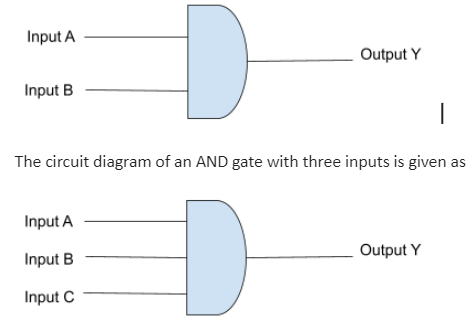Introduction to AND Gate – AND gate is a type of logic gate where a logic gate is an electronic circuit that follows certain logical relations between the inputs and the outputs. It is a basic digital gate. The inputs and output only contain two values: ‘ 1’ or ‘0’, ‘high’ or ‘low’, ‘true’ or ‘false’, ‘closed’ or ‘open’, ON’ or ‘OFF’ etc.
Meaning of AND Gate – AND gate is a digital electronic logical gate that takes input and performs multiplication on them. The output is the product of inputs. If all the inputs are set to high or ‘1’, only then the AND gate will give a high output, that is ‘1’.
The Circuit Symbol of AND Gate
The circuit symbol of an AND gate is a ‘D’ shape with input lines on the left side and one output line on the right side of the ‘D’. The circuit diagram of an AND gate with two inputs is given as

The circuit diagram of an AND gate with three inputs is given as
Boolean Expression of AND Gate
In Boolean Algebra, a single dot(.) is used to represent AND function.
The boolean expression for a two-input AND is given as
Y=A.B
The above expression is read as Y is equal to A AND B where A and B are the inputs and Y is the output.
Similarly, the boolean expression for a three-input AND function is given as
Y=A.B.C
The above expression is read as Y is equal to A AND B AND C where A, B and C are the inputs and Y is the output.
Truth Table of AND Gate
A truth table is a table that shows all the combinations of input and their corresponding outputs. Binary digits are used in the truth table. The AND logic is that the output Y will be true only when all the inputs are set high, which means all the inputs should have a value of 1.
The truth table of a two-input AND gate is given as
A | B | Y |
0 | 0 | 0 |
0 | 1 | 0 |
1 | 0 | 0 |
1 | 1 | 1 |
In the above table, there are four combinations of two inputs. The output is false for the first three inputs as the product of ‘0 AND 0’, ‘0 AND 1’, or ‘1 AND 0’ is always zero. Only the last combination of the inputs ‘1 AND 1’ gives a true output as it satisfies the AND logic.
The truth table of AND gate with three inputs A, B, C, and one output Y is given as
A | B | C | Y |
0 | 0 | 0 | 0 |
0 | 0 | 1 | 0 |
0 | 1 | 0 | 0 |
0 | 1 | 1 | 0 |
1 | 0 | 0 | 0 |
1 | 0 | 1 | 0 |
1 | 1 | 0 | 0 |
1 | 1 | 1 | 1 |
In the above table, there are eight combinations of three inputs. The output is false for the first seven combinations as their product is always zero. Only the last combination of the inputs ‘1 AND 1 AND 1’ gives a true output as it satisfies the AND logic.
Implementation of AND Gate
The logic gates can be implemented using diodes and universal logic gate NAND.
Using Diodes
A Diode is an electronic component. It allows the flow of current in one direction only. AND gate can be implemented by using two diodes and a resistor.
When both the inputs A and B are high, both the diodes are reverse biased, and no current is passed to the ground. There is no voltage drop across the resistor. Hence, the output, in this case, is ‘high’.
When both the inputs are low, the current flows through the diodes and the resistor and gives a ‘low’ output. When one of the inputs is low and the other is high, then one of the diodes becomes forward biased and the other reverse biased and gives a ‘low’ output.
Using Universal gate NAND
Logic AND can be implemented by using two NAND gates. To implement AND logic, give inputs A and B to gate 1 and then redirect the output of gate 1 to both the inputs of gate 2. The output of the NAND gate 2 will be the same as the output of an AND logic.
Conclusion
The AND gate is a logic gate that can accept two or more inputs but gives out only one output. It can be implemented by using universal gates as well as diodes. In digital electronics, data transmissions and alarm circuits are monitored by using AND gates. Digital measuring instruments also use AND gates. The IC number of AND gates are 7408 and 7411.
 Profile
Profile Settings
Settings Refer your friends
Refer your friends Sign out
Sign out







